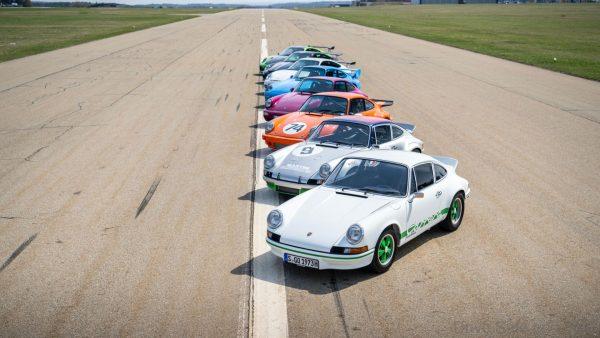Porsche 911 Carrera RS 2.7 ‘Ducktail’ Turns 50 This Year
A look back at the iconic Porsche 911 Carrera RS 2.7.
50 years ago, Porsche created the 911 Carrera RS 2.7 at the Paris Motor Show on October 5, 1972. The Porsche 911 Carrera RS 2.7 ended up becoming a new base vehicle for many other technical innovations and was the first to bear the ‘Carrera’ name. What started life a limited run of 500 examples for homologation as per Group 4 racing regulations ended up with 1,580 units being sold to customers, most of these within a year of showing the car. Of these 1580, 1,308 units were the touring version (M472), 200 were the lightweight ‘Sport’ version (M471), 55 units were the racing versions and 17 were base vehicles.

What was special about the Porsche 911 Carrera RS 2.7?
There are plenty of highlights to this particular model that Porsche produced. The first thing to note was that it was the fastest German production vehicle of its day. It was also the first Porsche model to bear the ‘Carrera’ badge – which is today found on even on lower variants of the 911. It was also the first series production model from Porsche to have staggered wheel sizes and to have both front and rear spoilers. The rear spoiler, in particular was significant, giving the car its ‘ducktail’ moniker.

On the Sport version (M471), the interior was stripped down to the essentials. Items that were removed – rear seats, carpets, the clock, coat hooks, and the armrest. Customers could even substitute the default front seats for lighweight seat shells. Other weight saving tricks included using thinner glass for the windows and using glue for the Porsche crest on the bonnet. This cut the weight down by 115kg versus the Touring (M472) model. It was also cheaper than the Touring model by 1800 Deutschmarks. The racing version, the 911 Carrera RSR (M491) was made with a larger engine displacement.

The New 2.7L Flat-Six Boxer
Powering the 911 Carrera RS 2.7 was a newly developed 2.7L boxer engine with fuel injection. This engine was put together by Hans Mezger and Valentin Schäffer. It produced 210PS at 6,300 rpm and 255Nm of torque at 5,100 rpm. The larger displacement required the use of Nikasil coating on the cylinder walls. The compression ratio, timing and valve diameter remained the same as what was found on the 2.4L engine.

In its fastest guise, the car was able to accelerate from 0-100km/h in just 5.8 seconds and hit 245km/h. The more common Touring specification did 6.3 seconds and 240km/h, which was not far off.

The New Ducktail Spoiler
Key to the 911 Carrera RS 2.7’s performance was the new aerodynamic enhancements. The aim was to minimise lift on the front and rear axles at high speeds for more neutral handling. The ducktail spoiler was hit upon after testing in the wind tunnel and on test tracks.

In the initial stages, sheet metal and wooden blocks were used to nail the shape in testing. The final shape of the spoiler complemented the unified bodystyle of the 911 while compensating for the drawbacks of the car’s shape. The new ducktail spoiler pushed the 911 Carrera RS 2.7 closer to the road at speed while also supplying the air with more cooling all without increasing drag.

The Porsche Museum will be showcasing the 911 Carrera RS 2.7 from the 20th of September 2022 onwards to celebrate its 50th anniversary.